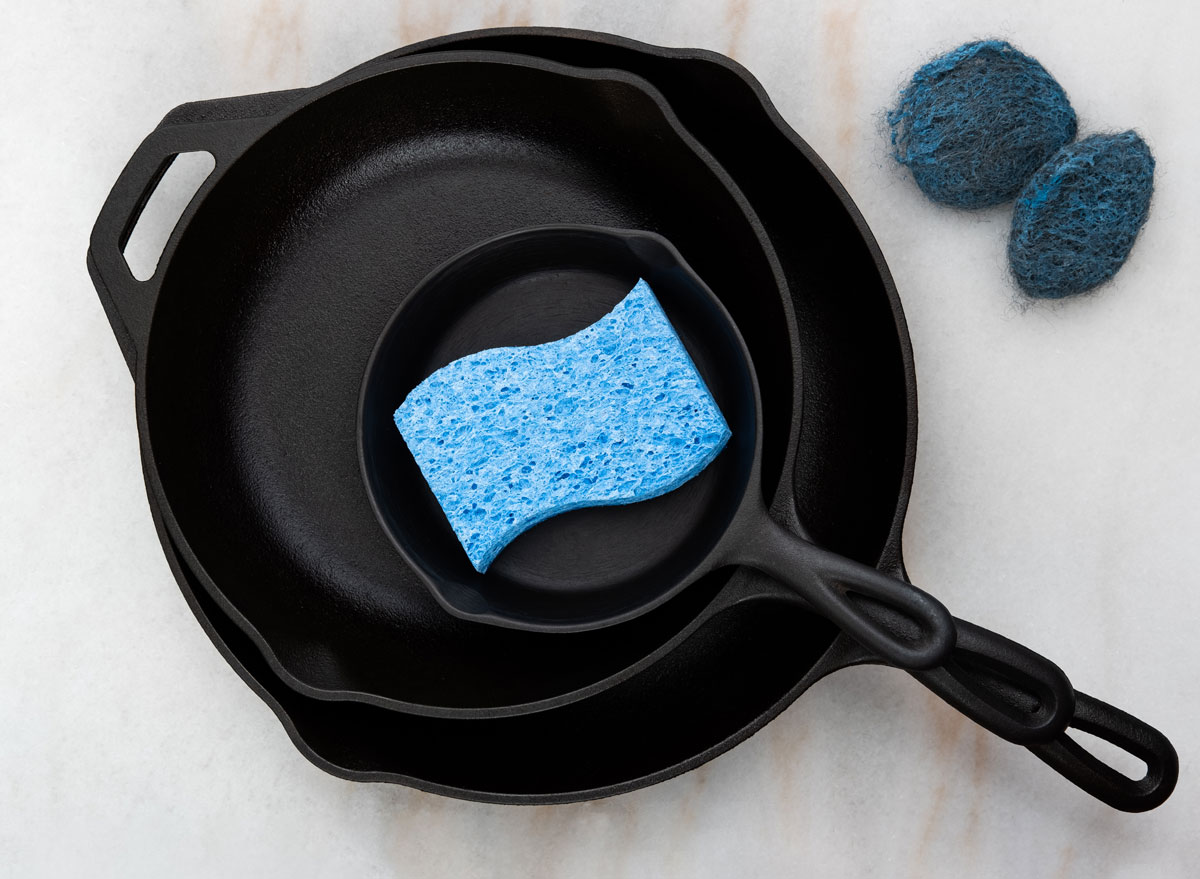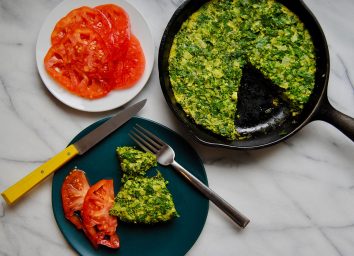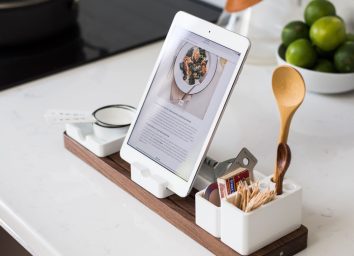The Best Way to Clean a Cast Iron Skillet, According to Experts

There’s a reason (actually, a few) why cast-iron skillets are heirloom cookware: they’re reliable, indestructible, multi-purpose, affordable, and extremely easy to use. Best of all, the more you cook with cast-iron cookware, the better it prepares all your favorite cast-iron skillet recipes. That is, of course, as long as you care for it properly.
Properly caring for and cleaning cast-iron starts with understanding what sets this cookware apart from the stainless steel or non-stick pans in your kitchen cabinets. The secret lies in an age-old process: seasoning.
No, we’re not talking about seasoning like salt and pepper. In this sense of the term, seasoning refers to the process by which you add a fat—like oil—to your cast iron to create a protective varnish that keeps your pan non-stick.
It’s this seasoning that has been at the root of a hotly debated topic in the culinary world: how do you clean a cast-iron skillet so that you maintain this seasoning but also make sure the pan is clean? And is it ok to use soap on your cast-iron cookware?
One school of thought is that you should absolutely never use soap on cast-iron. The assumption is that it could remove this non-stick seasoning and get rid of all those built-up flavors that get caked into the pan from years of use.
Others argue that not using soap to wash a pan is uncleanly and downright gross.
We set out to settle this debate once and for all. That’s why we wanted to see what a professional chef, the food experts at America’s Test Kitchen, and the makers of the famous cast-iron skillet—Lodge Cast Iron—had to say about how to clean cast iron.
STAY INFORMED: Sign up for our newsletter to get the latest food news delivered straight to your inbox.
What’s the secret behind cast-iron skillet seasoning?
Before Teflon non-stick pans, there was cast-iron. While you wouldn’t immediately assume that a pan made of smelted iron, stamped steel, and alloys would be non-stick, it somehow is. And you can thank the seasoning process for that.
“[Seasoning is] an age-old process. Back in the day, you would put lard or fat on the new skillet and bake it at a very high temperature,” Lodge Cast Iron public relations manager Mark Kelly told the Alliance for American Manufacturing in an interview.
Now, Lodge preseasons its pans with soybean oil, but the reasoning is still the same: to turn something as rough as iron into a smooth, non-stick surface. And the more you cook with your skillet, the better the “easy release” gets.
Kelly explained that whenever you cook anything in your skillet, the oil that’s emitted from the food “becomes carbon particles which enhances the seasoning, and everything moves on from there. The more you cook with it, the more carbon particles are created and that creates the easy release for the non-stick process.”
A properly-seasoned cast-iron skillet is just as non-stick as your Teflon pan. So non-stick, in fact, that you could even scramble eggs in it.
Now that we understand why it’s important to maintain your cast iron’s seasoning, let’s see what the best technique is to wash your pan.
How Lodge Cast Iron instructs you to clean cast-iron skillets
The Lodge brand is synonymous with cast iron skillets. The Tennessee-based company has been in business for almost 125 years and has claimed the title of America’s largest cast iron cookware company.
Who better to learn how to care for your cast-iron skillet than the people making the pan itself?
According to Lodge’s website, “Wash your cast iron cookware by hand. You can use a small amount of soap.”
You heard it here first! Lodge says it’s ok to use soap when washing your cast-iron skillet. For more serious, stuck-on food, the company recommends a scraper, like the one provided in its 5-piece cast iron care kit. These are the directions Lodge gives to care for your pan:
- Wash your cast iron cookware by hand. You can use a small amount of soap.
- Dry promptly and thoroughly with a lint-free cloth or paper towel
- Oil the surface of your cookware with a very light layer of cooking oil. Use a paper towel to wipe the surface until no oil residue remains.
How the food experts at America’s Test Kitchen clean cast-iron pans
America’s Test Kitchen is one of the most trusted brands in cooking that’s known for its scientific know-how and rigorous testing of cooking equipment, appliances, and recipes. We talked to Lisa McManus, Testings and Tastings Editor of ATK, to find out her preferred method of how to clean cast iron. “My preferred method of cleaning a cast iron skillet is really fast and really easy,” McManus tells us. Here are her steps:
- Remove any loose food you just cooked.
- Wash: Turn the hot water tap on to get it as hot as possible (to reduce thermal shock to the hot pan). Holding the still-pretty-warm skillet with a potholder, run the pan under the hot tap water, while lightly scrubbing it with a brush, with no soap. (This brush is our winner, for about $8, or any long-handled brush that keeps you out of the heat.)
- Dry: Wipe the pan lightly to dry, and return the pan to the burner you just cooked on. Turn the heat back on to low until the pan is completely dry, for a few minutes at most. (That keeps drops of water from trying to rust your pan between uses.) Shut off heat and let it cool right on that burner.
Although Lodge recommends seasoning cast-iron skillets after each use, McManus says that it’s not necessary to do it every time. “If the pan’s surface looks a little dried-out, add ¼ teaspoon (not kidding, that’s all you need, just a drop) of any kind of cooking oil, wipe it all over the interior with a paper towel, until it looks like you’ve wiped it all right back off. Leave it on low to medium-low heat for three or four minutes, then shut off the heat and allow the pan to cool in place on the burner.”
“Should you use soap? Normally you really don’t need it,” McManus tells us. “If you do what I just said, your pan will come clean with a good rinse and a light, no-soap scrub. If you have a pan you’ve been using a while and it has good seasoning, and you’ve got something super greasy, and you really want to use a drop of soap to cut it, it’s not going to kill your pan. You may need to do the wipe-over of ¼ teaspoon of oil after you’re finished, but it will be fine.”
What should you do if someone tried to help you clean up after dinner and used soap on your cast-iron pan? McManus reassures us “that’s ok, too. Just rinse it well, dry it, wipe it with a very light coat of oil, heat it on the stovetop for 5 minutes or so, and let it cool. It will be OK. Cast iron pans are completely indestructible. Have fun and don’t worry!”
How a professional chef cleans cast-iron skillets and pots
Claudia Sidoti, Head Chef and Recipe Developer at HelloFresh, tells us how she cleans her cast-iron cookware.
“Make sure to clean the skillet immediately after use, while it is still hot or warm,” Sidoti says. “If you soak the pan or leave it in the sink, it may start to rust.”
- Wash the skillet using hot water and a stiff mesh brush. Avoid using the dishwasher, as it can ruin the pan’s coating.
- To remove sticky food, scrub with a combo of coarse kosher salt and water. Then, wipe with a paper towel. Food that doesn’t want to come off can be removed by boiling water in the pan.
- Thoroughly dry the skillet. Using a paper towel, apply a light coat of oil to the inside of the skillet. Buff to remove any extra grime.
- Store the skillet in a dry place.
Looking for an alternative way to get your skillet scrubbed clean? Sidoti recommends one trusty tool that never fails to get the job done: “Another amazing tool is using a chain mail-style scrubber (like this one on Amazon), which gets rid of the most stubborn foods on skillets,” Sidoti says.
“The stainless steel rings create a textured surface that’s ideal for heavy-duty scrubbing. Once the pan is cool, fill it up in the sink with warm water. Then, use the scrubber to get every inch of the skillet. Rinse and repeat if food is still caked on. Dry with a cloth before storing to prevent rust.”
Conclusion
While methods vary for how to clean cast iron, there’s really no one right or wrong way to do it. (Well, except putting it in the dishwasher—do not put your cast-iron pan in the dishwasher.)
The consensus seems to be that you should use non-abrasive means of scraping food off the skillet (scraper, bristled scrubber brush, or chain mail — not steel wool), and that you don’t need to use soap (although it’s not bad if you do).
Cast-iron cookware is extremely forgiving, and it’s easy to rescue any rusted pan. So even if you accidentally let your pan soak in the sink overnight or you scrubbed it for a quarter of an hour trying to get caked-on food off, as long as you season your skillet properly afterward, you can continue using it as you did before.
Now that you know how to clean your trusty pot, put it to good use by searing a rib-eye to perfection, whipping up a veggie and cheese omelet, and trying your hand at these cast-iron skillet recipes.








